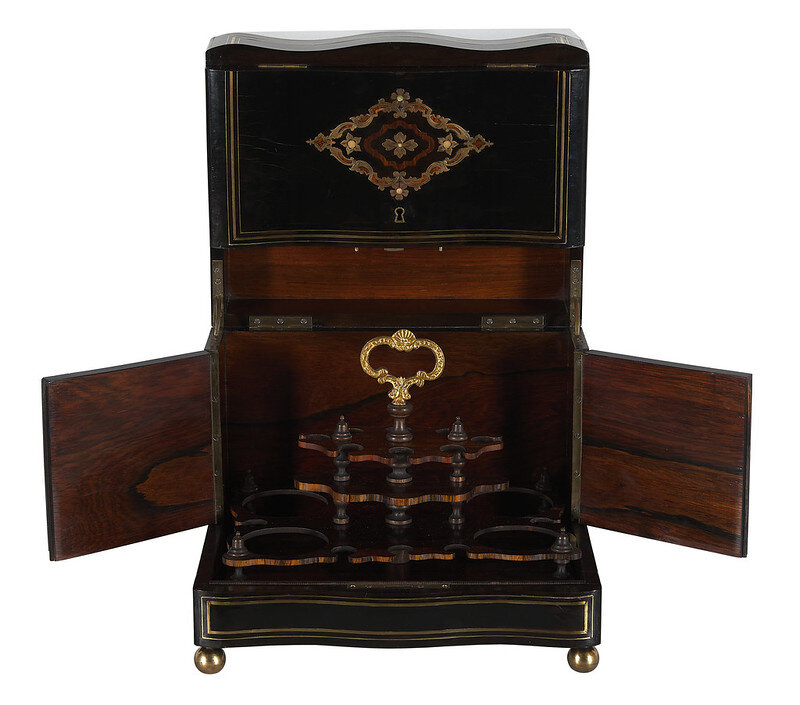When one thinks of Abraham Lincoln, what comes to mind may be a log cabin, a tall top hat, or even The Center’s home state of Illinois. One word that might not come to mind, however, is trendsetter. Yet President Lincoln was one of the first Americans to own a French Portable Bar, an object that would later become mass-produced and incredibly fashionable in the late 19th century. Despite the mass production of these boxes, our Antique and Fine Furniture Department was thrilled to work on another object owned by the 16th President of the United States (see other Lincoln-owned objects we’ve worked on here and here).
Before Treatment
Most of the repairs needed for Lincoln’s Bar were due simply to the age of the work. After over 150 years, the original polished finish of the box had largely deteriorated, most notably on the top and the back. Time had caused molding on the right side to become loose, scroll inlay on the front to spring loose, and various areas of the veneer to blister or detach from the surface. There were also multiple splits in the wood due to varying environments— which causes the wood to expand and shrink. One of these splits had been inadequately filled at some point in the object’s long history.
Before Treatment
Tape residue was found on the top of the piece. Inside the portable bar, some components of the tray were warped, and the second tier was split and sprung loose. The lock plate was bent and was missing its key.
Before Treatment- Detail of Lid
After Treatment- Detail of Lid
After initial photography and cleaning of the Bar, it was time to start the conservation work. All of the loose elements, including the molding, brass scroll inlay, and veneer fragments were glued using hot animal glue per the original makers choice, which also allowed us to comply with reversibility requirements.
Areas of missing veneer were filled with a pigmented, reversible resin, to match the surrounding surface. The shrinkage splits were stabilized, the warping of the tray was reduced as much as safely possible using compression setting techniques, and the tape residue was carefully removed from the surface.
Gently Shaving Down Pieces of Brass Stringing
Detail Showing Thinness of Brass Stringing
The most exciting aspect of this project—besides working on a Lincoln-owned item—was inserting new brass inlay, said our conservators. Over half of the original brass inlay was missing; luckily, we had more than enough on hand to replace it. The challenge was to size the stringing correctly so that it would fit into the grooves present on the Bar, without altering the size of the grooves. Using a tool normally reserved for cutting thin strips of wood, our conservators had to carefully shave off bits of brass at a time to get the perfect size.
Gluing Replacement Brass Into Original Grooves
Gently Shaving Down New Secured Brass to Become Flush with the Surface
Securing the Brass with a Brayer Tool
Cleaning and Unifying Pieces of Original and Replacement Brass
When the pieces were cut, they were adhered to the Bar with the same type of glue that the original manufacturer had used, while retaining the glue layer beneath. The brass strips were lodged into place with the help of a rosewood brayer tool (traditionally used to smooth wallpaper). Once the glue was dry, the brass had to be carefully scraped again so that it was flush with the surface of the wood.
Dismantling the Lock
The Newly Formed Key
Testing a Blank Key
Testing the New Key in the Lock- It Works!
Our conservators also decided to try and fabricate a new key to replace the one that was missing. The Bar utilizes a French double-throw lock, which means the key is rotated twice to unlock it. Coincidentally, one of our conservators happened to have a blank French key in his own collection, which he used for the project. A French key made during this time period consisted of an iron bit (the shaft that matches the lock) and a brass bow (the decorative head). The lock was taken out of the box and unscrewed to reveal the mechanisms inside. After a bit of filing down, the blank was fit to match this particular lock.
New Brass Feet
The piece was then reassembled with its new lock and key, looking nearly as good as new, yet retaining its age, patina, and character. Period-appropriate brass feet were sourced to replace the non-original wooden feet the Bar came with.
After Treatment
After Treatment
For extra protection against the tests of time, a protective wax coat was applied to the entire surface. We hope Lincoln’s Portable Bar will delight its viewers for another 150 years.


















